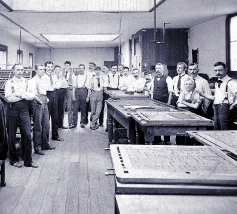The `Plain Dealer`
 The `Plain Dealer,` the first newspaper established in New Jersey expressly for the purpose of supporting the sometimes faltering drive for American liberty, is one of the literary-political landmarks of the American Revolutionary period. The distinguished historian, John T. Cunningham, said that the fact that the Plain Dealer appeared every Tuesday morning probably made it New Jersey's first regular "Newspaper."
The `Plain Dealer,` the first newspaper established in New Jersey expressly for the purpose of supporting the sometimes faltering drive for American liberty, is one of the literary-political landmarks of the American Revolutionary period. The distinguished historian, John T. Cunningham, said that the fact that the Plain Dealer appeared every Tuesday morning probably made it New Jersey's first regular "Newspaper." Potter's Tavern, in Bridgeton, where the Plain Dealer was published is one of New Jersey's most significant historical shrines. (The once popular retreat of citizens who called for independence from England has been carefully restored to its 1776 appearance.)
The editor of the Plain Dealer was Ebenezer Elmer, age 23, a native of Fairfield, a tea burner and a young physician who later distinguished himself as a soldier, a statesman and a public benefactor. He was the last survivor of Washington's officers of the Jersey Continental Line. He was also the last original member of the New Jersey Society of the Cincinnati and at his death was the president of that mutual aid organization formed by the officers of Washington's army when his troops were disbanded.
Containing clear and persuasive argument in favor of Liberty from British domination, the Plain Dealer successfully served to crystallize sentiment in Cumberland County in favor of armed resistance. This accomplished, the editor and the contributors went off to war.
The tavern bore the name of its licensed keeper, Mine Host Matthew Potter. He was a brother of David Potter, who was later a Colonel in the Militia. Matthew's place of entertainment was a gathering spot for the local firebrands. The fact that he gave a home to the Plain Dealer placed him in personal danger in the Revolutionary period. The silhouette on the cover of this booklet is the only likeness of Ebenezer Elmer so far identified.
The original manuscript of the Plain Dealer was in the hands of Bridgeton owners who held it by inheritance. In the 1930s, it found its way into the streams of trade finally coming to rest in the Rare Book Collection of Rutgers, The State University.
For more South Jersey History, visit our History page.
advertisement

Author: R. Cohen
Archives
Collingswood
A Southern Mansion
Light up the Night
Dining Alfresco
Sink or Swim
Throwing Shade
The Outdoors in Order
The Foundation
A New Spin on Swim
Gloucester Township
Wonderful Water
The Foundation: June, 2015
Community Connection: Moorestown
Things to Do
Cinnaminson
More...







